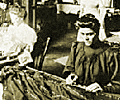|
Women's
Work
Suggested Requirements for Conducting an Interview
- Preparing for the Interview:
To prepare for your interview you should make clear the purpose for
conducting the interview. In this case, the purpose is to discover information
pertaining to women's work through interviewing someone from your family
or another woman that you know. Contact the person you will be interviewing,
explain the purpose for the interview, and arrange a time that the interview
will take place. Make sure to have your questions prepared before you begin
the interview so that you will gain the information that you want. Also
be prepared for the conversation to move to other areas of the subject
at hand. Use one of the questions you have prepared to bring the interview
back on track if you feel that the conversation is straying too far from
the purpose of your interview.
- Conducting the Interview:
Make sure that you are on time for the interview, that you are properly
prepared, and that you have the necessary recording materials. Have a time
line in mind for your interview but be prepared to be flexible as the interview
progresses. Use the questions you have prepared and add any more as you
feel necessary. Make sure to thank the person you have interviewed at the
end of the session.
- Analyzing the results:
Once the interview is completed, check the information you have gained
to ensure that you have answers to the questions you prepared and that
the interview provided you with the desired material. If you find that
you do not have all of the information you need, you may set up a second
interview to gain this information.
Women's
Work
Suggested Rubric: Interview Assignment
Student's Name:___________________________
Date:_________________________________
| Knowledge/Understanding |
Mark |
|
Below Average (0)
-demonstrates insufficient knowledge to conduct interview
with limited effectiveness |
Average (3)
-demonstrate sufficient knowledge to conduct interview with
effectiveness |
Above Average (5)
-demonstrates thorough knowledge to conduct interview with
a high degree of effectiveness |
/5 |
| Thinking/Inquiry |
|
|
Below Average (0)
-applies few inquiry skills to formulate relevant questions
with limited effectiveness |
Average (3)
-applies inquiry skills to formulate relevant questions with
effectiveness |
Above Average (5)
-applies inquiry skills to formulate relevant questions with
a high degree of effectiveness |
/5 |
| Communication |
|
Below Average (0)
-interviewer communicates with limited clarity
-interviewer displays limited active listening skills |
Average (8)
-interviewer communicates with adequate clarity
-interviewer displays adequate active listening skills |
Above Average (15)
-interviewer communicates with a high degree of clarity
-interviewer displays superior active listening skills |
/15 |
| Application |
|
Below Average (0)
-uses technology and equipment (i.e. Internet and audio/video)
with limited effectiveness
-makes connections (e.g. past, present, and future role
of women) with limited effectiveness |
Average (8)
-uses technology and equipment (i.e. Internet and audio/video)
with adequate effectiveness
-makes connections (e.g. past, present, and future role
of women) with adequate effectiveness |
Above Average (15)
-uses technology and equipment (i.e. Internet and audio/video)
with a high degree of effectiveness
-makes connections (e.g. past, present, and future role
of women) with a high degree of effectiveness |
/15 |
| Total Marks: |
/40
|
Comments (strengths/considerations for improvement):
|
























